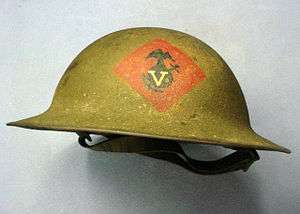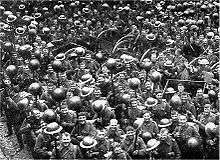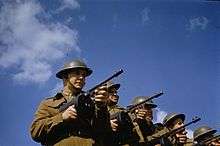Brodie helmet

The Brodie helmet is a steel combat helmet designed and patented in London in 1915 by John Leopold Brodie. In modified form it became the Helmet, steel, Mark I in Britain and the M1917 Helmet in the U.S. Colloquially, it was called the shrapnel helmet, Tommy helmet, tin hat, and in the United States the doughboy helmet. Worn by Australians during WW2 and sometimes known as Panic Hat. It was also known as the dishpan hat, tin pan hat, washbasin, battle bowler (when worn by officers), and Kelly helmet. The US version, the M1917, was copied from the British Mk 1 steel helmet of 1916. The German Army called it the Salatschüssel (salad bowl).[1] The term Brodie is often mis-used. It is correctly applied only to the original 1915 Brodie's Steel Helmet, War Office Pattern,[2]
Background

The caption reads:
Head-wounds have been more than usually numerous during the war, owing to the trench-fighting, and more than usually severe, owing to the extensive use of shrapnel. But the danger, although it cannot be avoided, can be minimised. Our Army has now followed the French by adopting steel helmets, calculated to stop shell-splinters and shrapnel. Even in cases of extreme risk, not only has death been avoided, but injuries have been confined to bruises or superficial wounds. Cases have occurred in which the wearers have been hit, but saved by these helmets from what without them would have meant certain death. The fur coats, as they did last year, mean mitigation of the rigours of winter. The French helmets are known as "Adrians," after their inventor. (Photo by Illustrations Harrow).
At the outbreak of World War I, none of the combatants provided steel helmets to their troops. Soldiers of most nations went into battle wearing cloth, felt, or leather headgear that offered no protection from modern weapons.
The huge number of lethal head wounds that modern artillery weapons inflicted upon the French Army led them to introduce the first modern steel helmets in the summer of 1915.[3][4] The first French helmets were bowl-shaped steel "skullcaps" worn under the cloth caps. These rudimentary helmets were soon replaced by the Model 1915 Adrian helmet, designed by August-Louis Adrian.[5] The idea was later adopted by most other combatant nations.
Origins
At about the same time, the British War Office had seen a similar need for steel helmets. The War Office Invention Department was ordered to evaluate the French design. They decided that it was not strong enough and too complex to be swiftly manufactured. British industry was not geared up to an all-out effort of war production in the early days of World War I, which also led to the shell shortage of 1915.
John Leopold Brodie (1873-1945), born Leopold Janno Braude[6] in Riga, was an entrepreneur and inventor who had made a fortune in the gold and diamond mines of South Africa, but was working in London at that time.[7] A design patented by him in August 1915 offered advantages over the French helmet. It was constructed in one piece that could be pressed from a single thick sheet of steel, giving it added strength and making it simple to manufacture. Brodie's patent deals mainly with the innovative lining arrangements; an engineer called Alfred Bates of the firm of Willis & Bates of Halifax, Yorkshire, a manufacturer of metal lamps, claimed that he was asked by the War Office to find a method of manufacturing an anti-shrapnel helmet and that it was he who had devised the basic shape of the steel shell. Aside from some newspaper articles, there is nothing to substantiate Bates's claim.[8]
Brodie's design resembled the medieval infantry kettle hat or chapel-de-fer, unlike the German Stahlhelm, which resembled the medieval sallet.[9] The Brodie had a shallow circular crown with a wide brim around the edge, a leather liner and a leather chinstrap. The helmet's "soup bowl" shape was designed to protect the wearer's head and shoulders from shrapnel shell projectiles bursting from above the trenches. The design allowed the use of relatively thick steel that could be formed in a single pressing while maintaining the helmet's thickness. This made it more resistant to projectiles but it offered less protection to the lower head and neck than other helmets.
The original design (Type A) was made of mild steel with a brim 1.5–2 inches (38–51 mm) wide. The Type A was in production for just a few weeks before the specification was changed and the Type B was introduced in October 1915. The specification was altered at the suggestion of Sir Robert Hadfield to a harder steel with 12% manganese content, which became known as "Hadfield steel", which was virtually impervious to shrapnel hitting from above.[10] Ballistically this increased protection for the wearer by 10 per cent. It could withstand a .45 caliber pistol bullet traveling at 600 feet (180 m) per second fired at a distance of 10 feet (3.0 m).[11] It also had a narrower brim and a more domed crown.

The original paint scheme, suggested by Brodie, was a mottled light green, blue, and orange camouflage but they were also painted in green or blue-grey.[12] That same month the first delivery of the helmets was made to British Army troops. Initially, there were far from enough helmets to equip every man, so they were designated as "trench stores", to be kept in the front line and used by each unit that occupied the sector. It was not until the summer of 1916, when the first one million helmets had been produced, that they could be generally issued.[13]
The Brodie helmet reduced casualties but was criticized by General Herbert Plumer on the grounds that it was too shallow and too light-reflective, its rim was too sharp, and its lining was too slippery. These criticisms were addressed in the Mark I model helmet of 1916, which had a separate folded rim, a two-part liner and matte khaki paint finished with sand, sawdust, or crushed cork to give a dull, non-reflective appearance.[12] In 1917, the liner was modified to include a rubber cushion to make it more comfortable, although this was not adopted for the M1917. Towards the end of the war, helmets were often painted with unit insignia. These are often called "parade helmets" by collectors.
The weight of a Mark I helmet was approximately 1.3 pounds (0.59 kg).
Service
It was first used in battle in April 1916 at the Battle of St Eloi. Troops from other countries also used the Brodie helmet, including the United States Armed Forces, when they began to deploy in France late in 1917. The United States government initially purchased some 400,000 helmets from Britain. From January 1918 the U.S. Army began to use helmets manufactured in the U.S. and these helmets were designated M1917.[1] The steel helmet was known to the troops as a "tin hat", or, for the officers, a "battle bowler" (from bowler hat).
By the end of the war some 7.5 million Brodie helmets had been produced, including 1.5 million M1917 helmets, for use by American forces.
Current safety concerns
In May 2014, the UK's Health and Safety Executive, in consultation with the Imperial War Museum, advised that World War I-era helmets were not safe to handle, owing to the likelihood of them containing asbestos. It advised that schools should not allow pupils to handle such artefacts, but should instead ensure that the objects were either safely disposed of, have the asbestos removed from the object or safely display the object.[14]
Post World War I

From 1936, the Mark I Brodie helmet was fitted with an improved liner and an elasticated (actually, sprung) webbing chin strap. This final variant served until late 1940, when it was superseded by the slightly modified Mk II, which served the British and Commonwealth forces throughout World War II. Several Commonwealth nations, such as Australia, New Zealand, Canada and South Africa, produced local versions of the MK II, which can be distinguished from those made in Britain. During this period, the helmet was also used by the police, the fire brigade and ARP wardens in Britain. The helmets for the ARP wardens came in two principal variants, black with a white "W" for wardens and white with a black "W" for Chief Wardens; however numerous different patterns were used.[15] A civilian pattern was also available for private purchase, known as the Zuckerman helmet, which was a little deeper but made from ordinary mild steel.
In 1944, the British replaced it with a significantly modified design, known as the Mk III "Turtle" helmet.
The U.S. Army used the basic Brodie-patterned M1917 helmet until 1942 with some modifications, which included a totally new liner and canvas chin strap. It was finally superseded by the M1 Helmet in 1942 and passed down to civil defense.
The helmet was the inspiration for the name of the Memorable Order of Tin Hats (or the MOTH), a brotherhood of ex-front-line soldiers founded in 1927 by Charles Evenden.
Variants
United Kingdom
- Brodie's Steel Helmet, War Office Pattern, Type A: the original 1915 helmet with the shell made from magnetic mild steel.
- Brodie's Steel Helmet, Type B: with the shell made from Hadfield (manganese) steel.
- Helmet, Steel, Mark I: introduced in Spring, 1916, a modified version of the Brodie helmet with a wholly redesigned liner and a mild steel rim to the shell. In 1917, a rubber ring or "doughnut" was added between the liner and the top of the shell, and in 1935, the liner and chinstrap were modified to make them removable.
- Helmet, Steel, Mark I*: introduced in 1938 and made up from old Mark I shells, but fitted with an all new liner and chinstrap. This was the standard British Army helmet at the start of the Second World War.
- Helmet, Steel, Mark II: also introduced in 1938, the Mark II featured a new shell with a non-magnetic rim (so that the wearer could use a magnetic compass) and the new liner and chinstrap used in the Mark I*. Early production went to the ARP services, the fire brigade and the police. It was re-designated in July 1940 as the Helmet, Steel, Mark II, No 1 and in the following year, as the Helmet, Steel, No 1, Mark 1.
- Helmet, Steel, Mark II, No 2: by July 1940, it had been realised that demand for the Mark II helmet could not be met, and so helmets which had either been rejected as substandard, or had been newly manufactured from cheaper mild steel, began to be issued under the designation "Mark II, No 2" to the Home Guard and civilian services. These helmets were marked with between one and four small holes drilled into the rim, showing the level of protection that they would provide. This type of helmet was re-designated in 1941 as the Helmet, Steel, No 2, Mark 1.[16]
- Helmet, Steel, Civilian, Civilain Protective Helmet or Zuckerman helmet: when it was found that a large number of civilians were needed to keep a lookout for fires started by incendiary bombs, an even cheaper mass-produced helmet was required. Designed by a team led by government adviser Solly Zuckerman, the thin mild steel helmet was broadly similar in shape to the military pattern but had a taller crown to the shell, providing space for the helmet to crumple. The simple liner was attached to the shell by a boot lace or string passed through holes in the shell. It was made available to civilian fire watchers at a cost of five shillings and sixpence (27½ new pence) each, starting in December 1940.
- Commercial helmets: in 1939, a number of British companies began to manufacture helmets for sale to concerned civilians. These usually had the appearance of Brodie-style helmets, but were generally made of cheap materials such as alloys, leather, resin-impregnated fibre or even Bakelite (an early form of plastic), and offered little protection to the wearer.[17]
Belgium
- M1949: a post-war Belgian-made copy of the Mark II helmet. The shell was identical to the British original, except that the liner fixing screw on the crown sat in a small indentation. The liner was of Belgian design and the chinstrap was copied from the British Mark III helmet.[18]
Canada

- Helmet, Steel, Mark II: having purchased British helmets in the First World War and at the outbreak of the Second, Canadian helmet production commenced in 1940. The helmets were identical to the British original, except that the rubber "bumper" pads in the lining were only fitted to horizontal helmet band and not to the vertical bands. The Mark II continued in front-line service with Canadian forces until March 1960.[19]
Portugal
- M1916: on Portugal's entry into the First World War in 1916, the country lacked the facilities to produce its own helmets and looked to the United Kingdom. British helmet production at that time was giving priority to their own forces, however the Director of Munitions Supply was able to source a commercially produced version of the Brodie helmet, originally intended to be sold to British officers at the time when helmets were in short supply. Given the Portuguese designation "M1916", it equipped the Portuguese Expeditionary Corps. Made of thin-gauge steel, the bowl was fluted in an attempt to add strength. Unfortunately, the fluting actually increased the chances of penetration if a missile hit one of the ridges, so some M1916s were produced with a plain bowl. A simple liner was laced to the shell through a series of holes.
- M1917: the Portuguese designation for the Mark I helmet, which was supplied as soon as the British production facilities became available.
- M1917/30: in 1930, the M1917 helmets were refurbished with a redesigned leather liner.[20]
United States
- M1917: initially the United States purchased 400,000 British Mark I helmets to equip the American Expeditionary Force in 1917, and those units which were to integrate with French formations were provided with Adrian helmets. The first US made copies of the Mark I were supplied before the end of 1917 and some 2,700,000 had been made by the end of the war. The M1917 differed little from the British original; different rivets were used to secure the liner, the wire loop onto which the chinstrap was fixed was thicker and the rubber "doughnut" pad was not adopted. However, the US manufacturers were able to produce a shell with better ballistic protection than the original.
- M1917A1: a redesigned liner and a new webbing chinstrap were approved for service in 1934. This model went into full production in 1941, when 904,020 were produced.
- M1917 Civil Defense Helmet: this helmet was produced to equip the Civil Defense Corps at the start of the war, and differed from the standard helmet in having a simplified liner and thin webbing chinstrap.[21]
Present day
Brodie helmets are still being used, most notably until recently, by the Israeli civil defence forces.
Some live-action role players use Brodie helmets as substitute Medieval chapel de fer. The Brodie helmet resembles its Medieval original enough to be an acceptable substitute.
See also
References
- 1 2 Reynosa, Mark A. (1997). "The M-1917 Helmet". U.S. Combat Helmets of the 20th Century. Atglen, PA: Schiffer Publ. ISBN 9780764303579. Retrieved 30 September 2015.
- ↑ "Brodie's Steel Helmet, War Office Pattern". The Brodie Helmet and its derivatives. 2015. Retrieved 30 September 2015.
- ↑ Suciu, Peter (2 February 2009). "The first modern steel combat helmet: the French 'Adrian'". Military Trader. Retrieved 30 September 2015.
- ↑ "Infantry Helmets". Military Headgears. Archived from the original on July 14, 2011.
- ↑ "Heaumes Page". Archived from the original on November 30, 2006.
- ↑ "Oxford Biography Index entry - John Brodie". http://www.oxforddnb.com/index/109/101109198/. Oxford University Press. External link in
|website=(help); - ↑ "Brodie's "Tin Hat"". www.buffalohistorygazette.net. The Buffalo History Gazette. 1 November 2010. Retrieved 10 August 2016.
- ↑ Liddle, Dr Peter (2016), Britain and a Widening War, 1915-1916: From Gallipoli to the Somme, Pen & Sword Military, ISBN 978-1-47386-717-8 (p. 182)
- ↑ Edwards, Nina (2013). Dressed for war : uniform, civilian clothing and trappings, 1914 - 1918. London: Tauris. p. 26. ISBN 9781780767079.
- ↑ Dunstan, Simon; Volstad, Ron (1984). Flak Jackets: 20th Century Military Body Armour. London: Osprey Publishing. p. 5. ISBN 0-85045-569-3.
- ↑ "Canadian Expeditionary Force Steel Helmets". kaisersbunker.com. 2006. Retrieved 30 September 2015.
- 1 2 Bull, Stephen; Hook, Adam (2002). World War I Trench Warfare (1): 1914–16. Oxford; New York: Osprey Publishing. pp. 10–11. ISBN 1-84176-197-4.
- ↑ Sheffield, Gary (2007). War on the Western Front: In the Trenches of World War I. Oxford; New York: Osprey Publishing. p. 227. ISBN 1-84603-210-5.
- ↑ Burns, Judith (14 May 2014). "Wartime helmets and gas masks 'dangerous', schools told". BBC News. Retrieved 30 September 2015.
- ↑ "London Blitz Civil Defence Helmets". military-history.org. 2014. Retrieved 30 September 2015.
- ↑ Brayley, Martin J (2008), Tin Hats to Composite Helmets: A Collector's Guide, Crowood Press, ISBN 978-1-84797-024-4 (pp. 58-60)
- ↑ Brayley, pp. 66-67
- ↑ Brayley, pp. 19-20
- ↑ Brayley, pp. 25-26
- ↑ Brayley, pp. 93-94
- ↑ Brayley, pp. 112-113
External links
| Wikimedia Commons has media related to Brodie helmets. |
- "стальной шлем" [Steel helmet]. helm.at.ua (in Russian). 2015.
- "Angleterre". World War Helmets: Référence de casques de 1915 à nos jours... (in French). 2015.